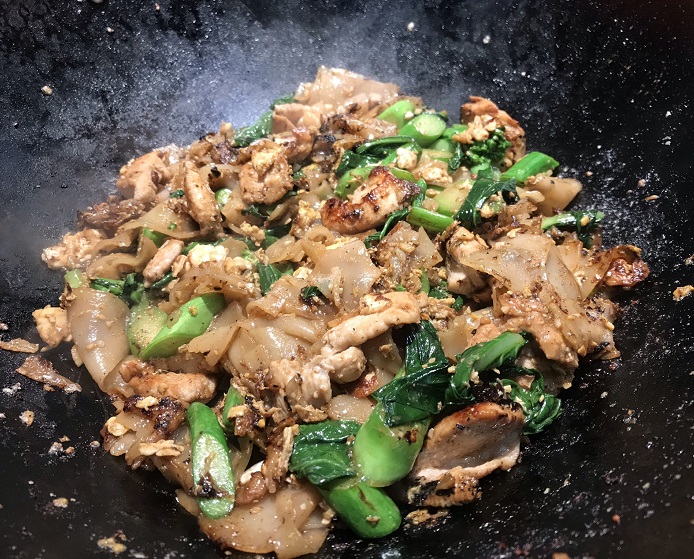Wok-fried rice noodle dishes have several permutations around Asia (e.g. Chow Fun in Hong Kong) and South East Asia (e.g. Char Kway Teow in Malaysia), and Pad See Ew (ผัดซีอิ้ว) is the Thai version of this popular concoction. In Thailand, Pad See Ew is a common fast food or street food item – you will find it at street food stalls, carts, and restaurants all around Bangkok, and the good ones will be packed with patrons around lunch hour. I wish American fast food culture here was this cool.
I think of Pad See Ew as a sibling to the iconic Pad Thai. “Pad” means to stir-fry in Thai, and “See Ew” means soy sauce. So yeah, “stir fry soy sauce”, it makes no sense – I know. I’m just the messenger 😆 All kidding aside, in Thai it actually translates to “stir fry with or in soy sauce”, which makes a lot more sense. Who knew prepositions were so important 🙄 (We will talk about “Pad Thai” in another post.)
Language lesson aside, the “See Ew” in this dish refers to a specific type of soy sauce commonly used in many Thai dishes – the “black soy” (see more about this in the ingredients section below). You can definitely get this online, but man it is a whole lot cheaper if you have an Asian grocer nearby.
As for the noodles, look for rice noodles that come uncut in whole sheets (I guess it’s not technically a “noodle” at this stage then, eh?). Chinese grocers generally have it, and (surprisingly) the Korean grocer near my house also has this in the uncut sheet form. Take a sharp knife and cut the sheet into 1 1/4″ inch strips, and separate them into strands, et viola! Noodle! More commonly, fresh rice noodles come already pre-cut into strips. I personally feel these pre-cut ones are cut too thin. So while pre-cut sheets will still work, it will be a thinner noodle with less surface area for the “charring” to happen.
For protein – you can use anything you want. Beef, chicken, pork, shrimp, tofu are all fair game. I typically use chicken or beef. While you can cook everything in the wok all at once, I prefer to quickly marinade the meat first, cook them separately, then add it back in at the end. This saves me from over cooking or under cooking anything.
Next, the vegetable. Pad See Ew is always made with Chinese Broccoli (Gai Lan), which is relatively easy to find in pretty much any Asian grocery store. Cut the stems into small pieces and then rough chop the leafy tops. The stems being thicker, will take longer to cook than the tops; so the idea is to cut the stem parts small so everything can cook under the same time. In some restaurants, I’ve seen carrot slices added in which isn’t really how it’s made in Thailand (ahem … carrots aren’t from Thailand) but I guess this is up to you. I add bean sprouts to my Pad See Ew all the time, and that’s technically not an ingredient either 😛
The last key ingredient is egg, which is scrambled directly in the wok. Use 1 or 2 eggs per serve, depending on how “eggy” you want it.
Finally, a word on the “charring” or “toasting” of the noodle. To me, this is a key signature characteristic of this dish, and is what separates Pad See Ew from other similar wok-fried noodle dishes. The charring really gives it that street food, wok-fried, smoky aroma that’s iconic with Pad See Ew. Toasting of the noodle is achieved by letting your noodle sit in contact with the hot wok for a minute or so (depending on how how your wok gets). This causes the sugar in the soy sauces and the starch in the noodle to caramelize. Do this a few times to get some charring throughout the dish.
Once you are done, serve it up with a side of chili vinegar to cut the salty/sweet sauce, white pepper for a little heat, and extra grounded Thai chili pepper (for even more heat!).
And that’s it. Nothing to it. Just remember this is “fast food” so once you start throwing stuff in the wok, it’s going to go fast. Do yourself a favor and make sure you have all the ingredients pre-portioned out and at your finger tips. You don’t want to be fumbling around, looking for anything once you get started. Enjoy!
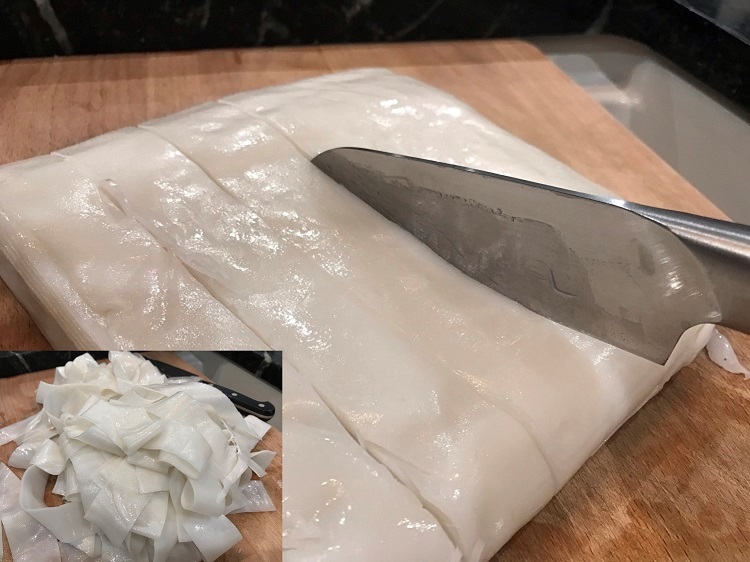
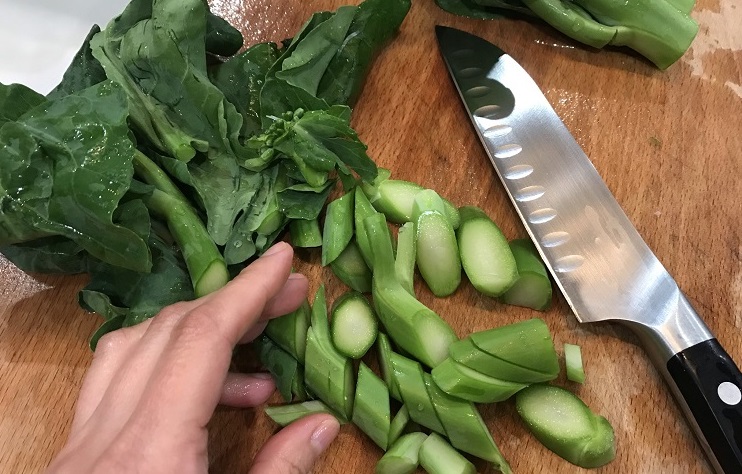
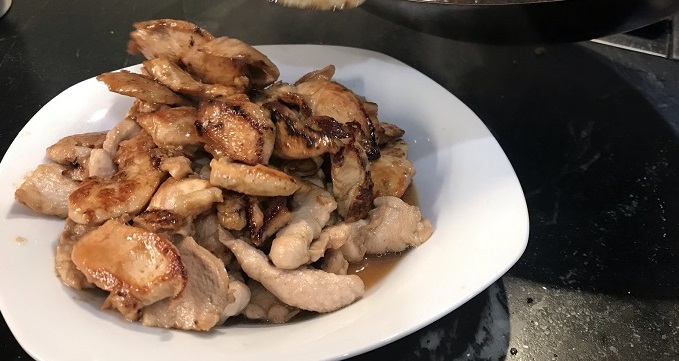

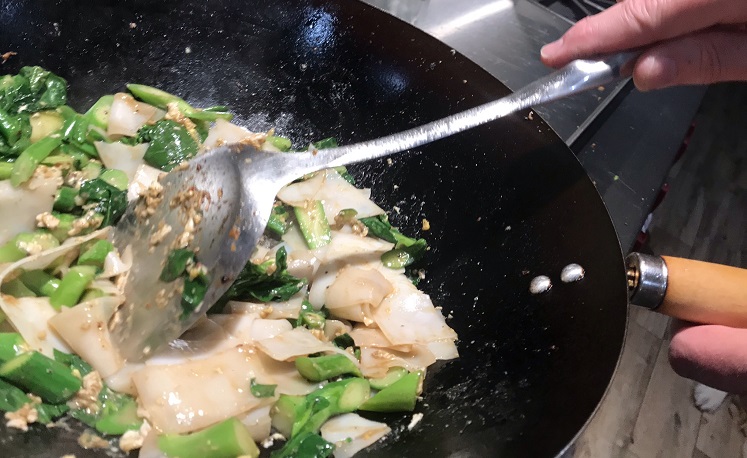
About the Ingredients
Rice Noodles
The key to this dish is thick rice noodles. They will either come pre-cut or uncut in whole sheets as shown here. My preference is to buy the whole sheet kind, and slice it myself so I can control the thickness of the noodle. The pre-cut ones are always too thin, although they will still work. You’ll just get less surface area to “char” the noodles.
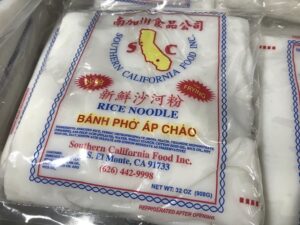
Chinese Broccoli (Gai Lan)
This might be one of my favorite Asian vegetables! It’s so versatile between different Asian cuisines and used in both soups and stir fry dishes. They are also relatively easy to find. You can find Chinese broccoli at any Asian grocery store (Thai, Chinese, Korean, you name it) – that’s how versatile it is. The stalk of the broccoli is can be little fibrous, so depending on how much stalk is included, you may need to peel the very bottom parts, or just cut them off. If you get ones that look like the picture here, you are good. No peeling needed. Slice the stems thin (maybe about 1/2 – 3/4 inch) on a bias, then rough chop the leafy top.
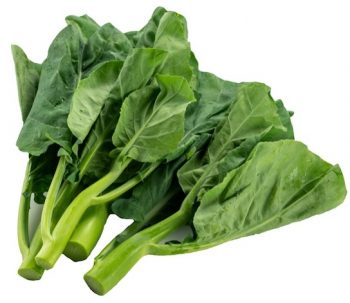
Black Soy sauce
I use Dragonfly Brand (there’s a dragon fly on the front label). This soy is the one with the orange cap and green label. (Not to be confused with the “sweet soy” from the same brand that has the blue cap and blue label). Similar to the sweet soy in the blue cap, this soy adds sweetness with less saltiness than regular soy sauce. If you plan on making a lot of Thai food, this is a pantry staple as it is used in many stir fries, noodles, soups and marinades.
In this dish, “See Ew” means soy sauce, and specifically this soy sauce. If you can’t find it, you can use more regular soy but it won’t have the same iconic taste that people associate with Pad See Ew.
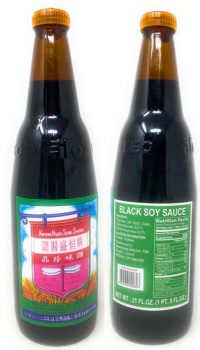
Golden Mountain Seasoning Sauce
This is a quintessential Thai seasoning. If you plan to make a lot of Thai food, I would recommend you have this in your pantry. Golden Mountain seasoning sauce is very similar to Tamari or Maggi sauce. Its flavor is like soy but with a hint of sweetness. You should be able to find this on Amazon, but if you don’t have it, you can substitute with regular soy, Tamari, or even Bragg’s Amino instead.
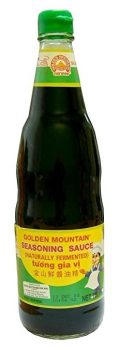

Pad See Ew
Equipment
- Wok (or a large stir fry pan)
Ingredients
Sauce (yields about ½ cup; use about 2½ tablespoon per serving)
- 4 tbsp oyster sauce
- 2 tbsp soy sauce
- 1 tbsp fish sauce
- 1 tbsp Golden Mountain sauce, see post
- 1½ tbsp black soy sauce, see post
- 1½ tbsp sugar
Protein & marinade (marinade is for 4 portions of protein)
- 1 lb protein of your choice (chicken, beef, pork, shrimp, tofu), use 125g (4-5 oz.) per serving
- 2 tbsp soy sauce
- 1 tsp oyster sauce
- ½ tsp white pepper
Everything else
- 8-10 cloves garlic minced, use about 1 tbsp per serving
- 1 packet fresh rice noodles (see post), use about 100 (3-4 oz.) grams per serving
- 4 eggs, use 1 egg per serving
- 8 stalks Chinese broccoli (Gai Lan), use 2 stalks per serving, about 2 cups chopped
- bean sprouts (optional), not really part of this dish in Thailand but dangit, I like it!
Condiments to serve
- grounded Thai chili pepper
- chili vinegar
- white pepper
How I Make It
Prep work
- Mix the sauce ingredients in a small bowl and set aside.
- Slice & marinade the proteins. If you are using chicken, beef, or pork, slice it thin and against the grain. If using shrimp, peel and devein. Combine the marinade ingredients with the protein, and let marinade for 10-15 minutes. Then stir-fry the protein in a hot wok with a little bit of oil until cooked through; you may need to do this in batches. Discard the accumulated liquid, and set aside.
- Prepare the noodles. If you are using sheets, cut the sheet into thick strips (about 1¼ inch thick) and separate into individual strands. Portion out a small bunch for each serving (about 100g or 3-4 oz.)
- Cut the Chinese broccoli into pieces, starting with the stems. Cut the stems into small pieces (thick pieces will take too long to cook). Cut at a bias if you want the pieces to seem bigger, yet still thin enough to cook quickly. When you get to the leaves, you can cut the leaves into large chunks. These will easily wilt and cook so don't cut them small. Portion out a couple cups per serving.
Before you start cooking
- Make this one plate (serving) at a time. This will help with the toasting of the noodles and achieve that "charred" wok taste. Making a large batch will limit your ability to get the wok hot enough to achieve this.
- Portion out each ingredient and organize them so everything is within reach. This is "fast food" so like any stir fry, it will go quickly. You don't want to fumble around measuring or looking for ingredients during the process.
Now let's cook! Get ready, this goes fast.
- Heat your wok with a couple tablespoon of oil on high heat (as high as you can go) and add your garlic. Don't wait until the wok/oil is hot before adding the garlic or you will burn your garlic. As the oil heats up, the garlic will begin to sizzle and become aromatic.
- Crack an egg into the oil, let it set for a couple of seconds, then scramble the egg in with the garlic.
- Once the egg is scrambled (don't worry if it isn't 100% cooked through), add the Chinese broccoli. Make sure you keep everything moving in the wok, constantly tossing and flipping your the vegetable. Do this for about 10-15 seconds.
- Add the portion of noodle, and keep tossing and flipping everything together for a few more seconds. Add in the sauce (about 2 ½ tbsp per serving), and keep flipping and tossing for another 10 seconds or until everything is well combined.
- Once the sauce is mixed through and the noodles are coated, spread out the noodles in the wok to give maximum contact to the wok surface. Leave it to "toast" for a minute, then toss again. Toasting time may be a little longer or shorter, depending on how hot your wok can get. The noodle (and even the egg) will start to have "char" marks, which is a sign that you are doing it right! Do this a couple more times until you get some nice charring throughout. (Don't go too crazy though, you don't want to burn the dang thing).
- When you are happy with the charring, add the protein back in and toss a few more times. Do not add any liquid or juices that may have accumulated from the protein or your noodles will become soggy.
- If you are using bean sprouts (again, not really authentic but dangit I like it!) add it at this point and toss through. You can also some grounded Thai chili pepper now and toss it through if you want. Otherwise you can serve it on the side.
- Serve with a side of chili vinegar, white pepper, and (if you're me) more grounded Thai chili pepper.

